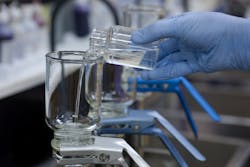Self-Assembled Amphiphiles Used for Water Purification Efforts
Climate change is causing an unprecedented water crisis. While parts of the world suffer megadroughts, others experience more frequent extreme events and floods [1, 2]. Without immediate action, this situation will worsen. Even if adequate action were taken today, reversing the current climate patterns would require time. In light of this scenario, water preservation is necessary. This should be achieved by purifying and reusing water, using energy-effective methods.
There are different classes of pollutants, each of which requires a specific approach. The Pensini lab previously investigated methods to immobilize and treat toxic immiscible solvents in groundwater, such as hydrocarbons (e.g., gasoline).
Water miscible solvents differ from toxic immiscible solvents, such as gasoline, which floats on water and does not mix with it. A familiar example of a miscible solvent is ethanol, i.e., the (less toxic) solvent found in alcoholic beverages and disinfectants. Examples of more toxic miscible solvents are acetonitrile and tetrahydrofuran (THF), which are found in both industrial wastewater and in contaminated aquifers close to industrial sites. Water miscible solvents are particularly problematic because their migration in groundwater is fast compared to immiscible solvents. Also, their removal from water is more challenging. Current purification methods, such as pervaporation, are energy intensive.
Therefore, the Pensini lab is now focusing on the treatment of miscible solvents, in collaboration with the Marangoni and Laredo labs. To this end, they are using amphiphiles.
Amphiphiles are molecules with moieties that love water (hydrophilic) and moieties that do not (hydrophobic). The lab has been using selected amphiphiles to purify water. Examples include sodium lauroyl lactylate [3], glycerol monooleate GMO [4], hydroxystearic acid HSA [5] and lauric acid [6]. All these amphiphiles are benign.
Amphiphiles initiate solvent separation because their hydrophilic moiety preferentially interacts with water, mainly through hydrogen (H) bonds, thereby displacing the solvent. When the solvent is excluded from the water network, it separates from water. This leads to water purification.
Separation into a free water phase starts with kinetically stable emulsions, i.e., dispersions of the solvent in water, or vice-versa. These kinetically stable emulsions are stabilized by self-assembled amphiphile structures, which range from reverse micelles to gyroid cubic phases. This is demonstrated by synchrotron x-ray diffraction (XRD) in the small angle x-ray scattering (SAXS) region. The characteristics of self-assembled amphiphile structures control the kinetics of emulsion destabilization. Faster kinetics are best because they lead to rapid separation into bulk phases. The facilities available at the Canadian Light Source (Saskatoon, Saskatchewan) have been instrumental for this research. There, we also used infrared (IR) micro spectroscopy to demonstrate compositional differences between kinetically stable emulsion droplets and the continuous phase. In other words, IR micro spectroscopy allowed us to create a chemical map of our samples. Finally, nuclear magnetic resonance (NMR) demonstrated compositional differences between separated bulk phases.
Amphiphiles are not the only molecules that can separate solvents. Sugars and sugar alcohols (e.g., the commercial sweeteners erythritol and maltitol) do too [7, 8]. Amphiphiles are unique though, in that they can simultaneously separate miscible solvents and toxic ions, such as copper, from water. This is the reason for which they are our focus. We have for instance demonstrated that hydroxy stearic and lauric acid simultaneously separate copper and THF from water [5, 6]. This is relevant, since industrial wastewater and groundwater are often co-polluted by metal ions and organic solvents. Segregating toxic metal ions into the organic phase may extend the boundaries of bioremediation using bacteria. Bioremediation is a cost-effective method to degrade organic pollutants, provided that the environment is not toxic to the bacteria. Excessively high organic pollutant concentrations and toxic metal ions can hamper bacterial growth and survival, thereby impeding bioremediation. We hypothesize that metal ion toxicity would decrease upon decreasing their concentrations in water, by inducing their migration into the organic phase. Our next objective is to purify water through treatment trains, which involve treatment with amphiphiles as the first step, followed by bioremediation using bacteria.
The advantage of the proposed method is that it can be used without heating polluted water at high temperatures, dissimilar to other methods currently available (e.g., pervaporation). Also, its implementation is facile and applicable to groundwater treatment, where complex treatment plants are not an option.
Our current research focuses on identifying tools to optimize amphiphile selection for the removal of diverse miscible solvents and ions from water, with the goal of enhancing purity.
Author:
Erica Pensini, PhD, P.Eng, is an associate professor at the School of Engineering, University of Guelph. Pensini can be reached at [email protected].
References:
Researchers: Erica Pensini1*, Alejandro G. Marangoni2, Thamara Laredo3
1- University of Guelph, School of Engineering, 50 Stone Road East, Guelph (ON), N1G 2W1, Canada
2-University of Guelph, Food Science Department, 50 Stone Road East, Guelph (ON), N1G 2W1, Canada
3- Lakehead University, Chemistry Department, 500 University Ave, Orillia (ON), L3V 0B9, Canada
Erica Pensini | Associate professor
Erica Pensini is an associate professor at the School of Engineering, University of Guelph. Pensini can be reached at [email protected].






